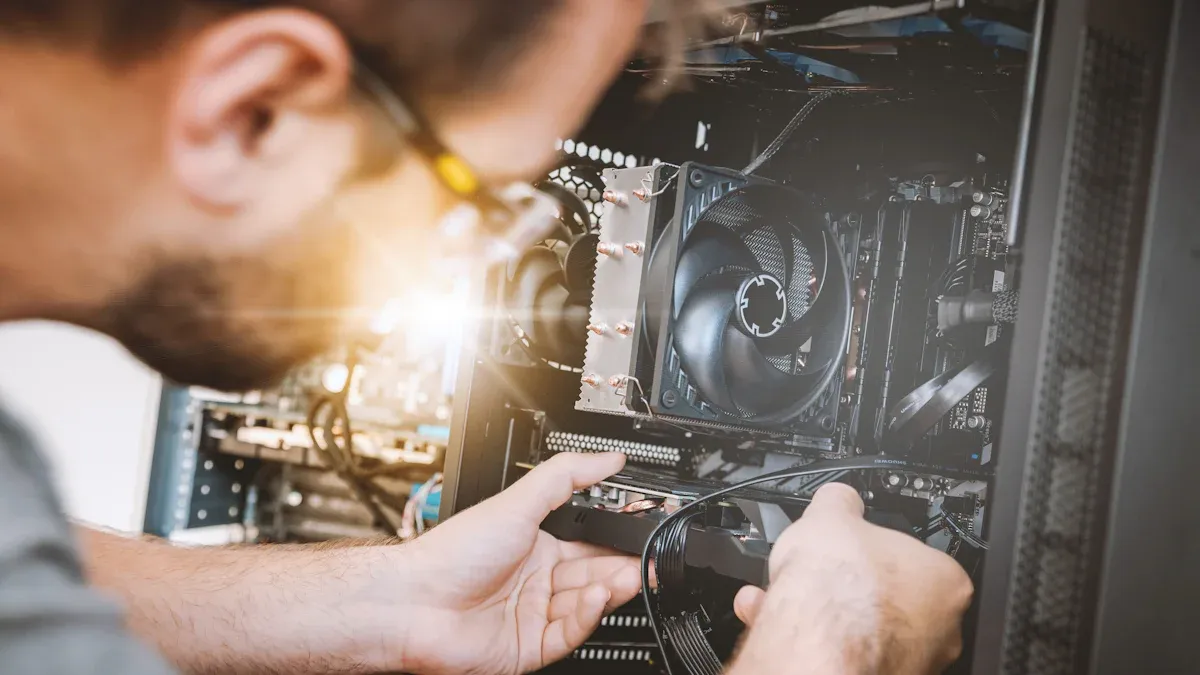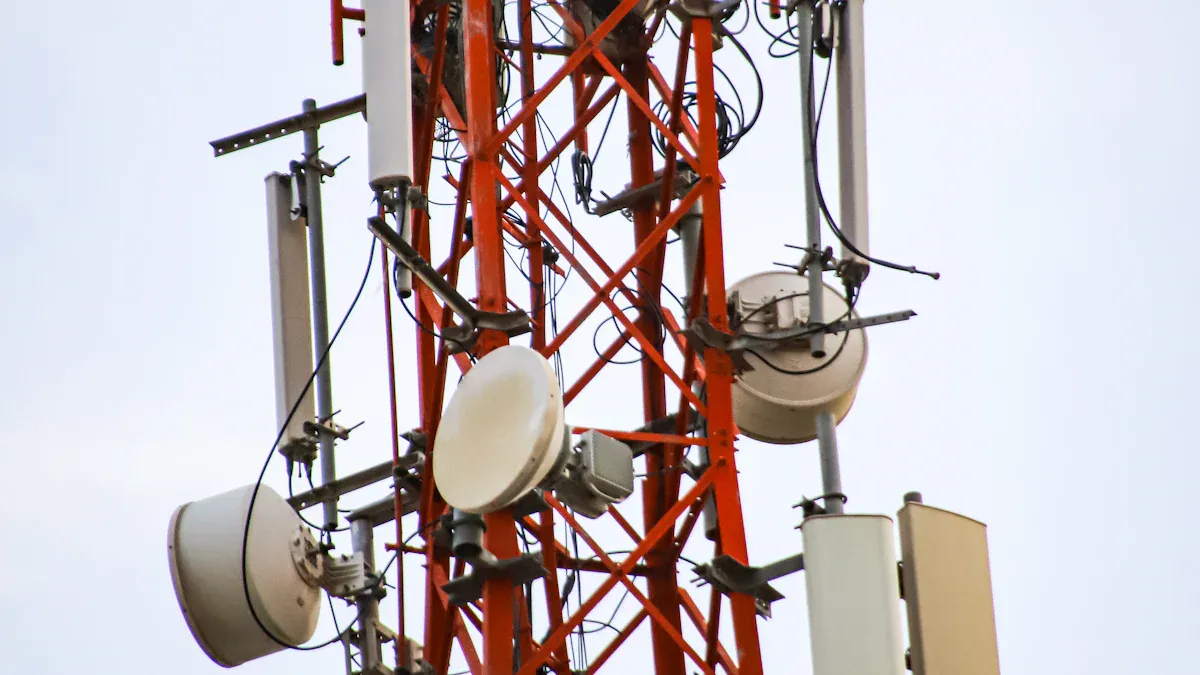
Analog industrial telephones play a crucial role in tough environments like 광업 산업 전화 sites and factories. Dust, moisture, and extreme temperatures can damage them over time. Regular cleaning and inspections keep them reliable. Using waterproof industrial telephones and IP weatherproof telephones ensures they withstand harsh conditions. Proactive care prevents costly repairs and downtime.
Challenges Faced by Analog Industrial Telephones in Harsh Areas

Environmental Stressors and Their Effects
Harsh environments can take a toll on analog industrial telephones. Extreme temperatures, moisture, and mechanical stress are common challenges. High heat can cause parts to expand, leading to misalignments or cracks. Cold temperatures may make materials brittle, increasing the risk of breakage. Moisture, whether from humidity or direct exposure to water, can corrode internal components and disrupt electrical connections.
Mechanical stress, like vibrations or impacts, can also damage these devices. For example, compressive or tensile forces may shift internal parts, causing performance issues. These stressors don’t just affect the phone’s durability—they can also lead to inaccuracies in communication, which is critical in industrial settings.
Common Failures in Harsh Conditions
Failures in analog industrial telephones often stem from environmental stressors. Moisture-related issues are among the most frequent. A spilled pitcher of water can cause an outage lasting up to eight hours. Wet cords are another problem, costing companies roughly $1 per incident. Bell Telephone addressed this by installing moisture-proof cords, saving $90,000 annually—a figure equivalent to $1.6 million today.
Physical damage is another common failure. Vibrations from heavy machinery or accidental impacts can loosen connections or crack casings. Over time, these issues worsen, leading to complete device failure. Regular maintenance and the use of rugged designs can help prevent these problems.
Selecting Durable Analog Industrial Telephones
Key Features for Harsh Environments
When choosing an analog industrial telephone for harsh areas, certain features are non-negotiable. These devices must handle extreme conditions while maintaining reliable performance. Research highlights three key characteristics: 연락처, resistance to dust and moisture, and ease of installation. Rugged construction ensures the phone can withstand physical impacts and vibrations common in industrial settings. Dust and moisture resistance protect internal components from environmental damage, extending the device’s lifespan. Finally, ease of installation simplifies deployment in remote or challenging locations, saving time and resources.
These features make analog industrial telephones a dependable choice for industries like mining, oil and gas, and manufacturing. Their ability to function in severe conditions ensures uninterrupted communication, which is critical for safety and operational efficiency.
Importance of Weatherproof and Rugged Designs
Weatherproof and rugged designs are essential for analog industrial telephones in harsh environments. These designs protect the devices from rain, snow, and extreme temperatures, ensuring they remain operational. Approximately 30% of industrial enterprises still rely on analog systems due to the high costs of transitioning to digital. This reliance underscores the need for durable designs that can handle tough conditions.
The table below highlights additional reasons why weatherproof and rugged designs are vital:
| Evidence Type | 이름 * |
|---|---|
| Demand Statistics | Approximately 30% of industrial enterprises still use analog systems. |
| Compliance Influence | Regulatory mandates require reliable communication lines for emergencies. |
| Worker Comfort | About 60% of workers prefer familiar analog systems over digital ones. |
These statistics show that analog industrial telephones remain a preferred choice in many industries. Their rugged and weatherproof designs ensure they meet both operational and regulatory demands.
Proactive Maintenance Practices
Cleaning and Dust Removal
Dust and dirt can quickly accumulate on an analog industrial telephone, especially in harsh environments like factories or outdoor sites. Over time, this buildup can block essential components, such as the microphone or speaker, reducing sound quality. Regular cleaning prevents these issues and keeps the device functioning properly.
To clean the telephone, use a soft, lint-free cloth to wipe down the exterior. For stubborn grime, a slightly damp cloth with mild soap works well. Avoid using harsh chemicals, as they can damage the surface or internal components. For hard-to-reach areas, a small brush or compressed air can remove dust effectively.
팁: Schedule cleaning sessions weekly or bi-weekly, depending on the environment. Consistency is key to preventing long-term damage.
Inspecting Seals, Gaskets, and Casings
Seals, gaskets, and casings are the first line of defense against environmental stressors. They protect the internal components from moisture, dust, and temperature fluctuations. However, these parts can wear out over time, compromising the telephone’s durability.
Inspect these areas regularly for cracks, gaps, or signs of wear. Pay close attention to the edges of the casing and the seals around buttons or ports. If any damage is found, replace the faulty part immediately. Ignoring these issues can lead to water or dust entering the device, causing internal failures.
참고 : A quick visual inspection during routine maintenance can save hours of troubleshooting later.
Addressing Wear and Tear Early
Even the most durable analog industrial telephone will experience wear and tear over time. Buttons may become less responsive, cords might fray, or connectors could loosen. Addressing these issues early prevents them from escalating into major problems.
Create a checklist to monitor the condition of each component. For example, test the buttons to ensure they respond correctly and check the cord for any visible damage. If a part shows signs of wear, replace it promptly. Keeping spare parts on hand can minimize downtime and ensure uninterrupted communication.
Reminder: Proactive repairs are always more cost-effective than emergency replacements.
Enhancing Protection Against Environmental Damage

Using Protective Enclosures
Protective enclosures act as a shield for analog industrial telephones in harsh environments. These enclosures keep out dust, moisture, and other harmful elements that could damage the device. They are especially useful in areas with heavy rainfall, high humidity, or frequent dust storms.
When selecting an enclosure, it’s important to choose one made from durable materials like stainless steel or reinforced plastic. These materials resist corrosion and can handle impacts. Some enclosures also come with additional features, like locks, to prevent tampering or theft.
Installing these enclosures is straightforward. Mount the telephone inside the enclosure and ensure all openings are sealed tightly. This setup creates a barrier that protects the phone without affecting its functionality.
팁: Look for enclosures with an IP (Ingress Protection) rating of 65 or higher. This rating ensures the enclosure is both dust-tight and water-resistant.
Applying Corrosion-Resistant Coatings
Corrosion is a silent enemy in industrial settings, especially in areas near saltwater or chemical exposure. Over time, it can weaken the structure of an analog industrial telephone and cause internal failures. Applying corrosion-resistant coatings is an effective way to combat this issue.
These coatings create a protective layer over the telephone’s surface, preventing moisture and chemicals from reaching the metal parts. Options like epoxy or polyurethane coatings are popular because they are long-lasting and easy to apply.
Before applying the coating, clean the surface thoroughly to remove any dirt or grease. Use a brush or spray to apply the coating evenly, and let it dry completely before reinstalling the telephone. Regularly inspect the coating for chips or wear and reapply as needed.
Reminder: Corrosion-resistant coatings not only extend the life of the telephone but also reduce maintenance costs over time.
Ensuring Proper Installation Techniques
Even the most durable telephone won’t last if it’s installed incorrectly. Proper installation techniques are crucial for ensuring the device can withstand environmental challenges.
Start by choosing a location that minimizes exposure to direct sunlight, heavy rain, or strong winds. If possible, install the telephone under a canopy or roof for added protection. Use sturdy mounting brackets to secure the device and prevent it from shifting due to vibrations or impacts.
Pay close attention to cable management. Loose or exposed cables can become entry points for moisture or pests. Seal all cable entry points with grommets or weatherproof tape to keep the system airtight.
참고 : A well-installed telephone not only lasts longer but also performs more reliably, reducing the risk of communication failures.
Monitoring and Testing for Optimal Performance
Routine Functionality Checks
Regular checks ensure analog industrial telephones perform reliably in demanding environments. These checks focus on voice quality, network metrics, and device responsiveness. For instance, measuring speech clarity and background noise interference helps identify issues early. Tools like POLQA algorithms assess voice transmission quality, while network metrics such as latency and jitter reveal potential communication delays.
Here’s a quick look at key metrics:
| Metric/Method | 이름 * |
|---|---|
| Voice Quality Measurements | Assessing voice transmission using algorithms like POLQA. |
| Network Metrics | Monitoring latency, jitter, packet loss, and network availability. |
| Device Testing | Evaluating voice codec performance and device capacity. |
| Speech and Noise Levels | Measuring speech clarity and background noise interference. |
| Call Setup Analysis | Analyzing the efficiency of call setup processes. |
| DTMF Sequence Analysis | Testing the accuracy of Dual-Tone Multi-Frequency signaling. |
| SLA Management | Monitoring service level agreements for compliance with quality standards. |
| Remote Access | Utilizing APIs for remote monitoring and management of devices. |
팁: Schedule functionality checks monthly to catch issues before they escalate.
문제 해결 및 수리
When performance dips, troubleshooting identifies the root cause. Multimeter testing checks continuity and resistance, ensuring components function properly. Continuity testing verifies circuit pathways, while individual component tests ensure transmitters and receivers respond correctly.
| Methodology | 이름 * |
|---|---|
| Multimeter Testing | Tests continuity and resistance of components for accurate results. |
| Continuity Testing | Checks circuit pathways for proper functionality using an ohmmeter. |
| Component Testing | Evaluates individual parts like receivers and transmitters for responsiveness. |
| Repair Techniques | Basic tools and soldering skills can fix vintage telephones effectively. |
Reminder: Keep a troubleshooting guide handy to streamline repairs.
Stocking Essential Spare Parts
Downtime can be costly, especially in industries relying on analog industrial telephones. Stocking spare parts prevents delays caused by unpredictable demand patterns. An efficient inventory system ensures critical components like cords, buttons, and casings are always available.
- Spare parts inventory management reduces operational downtime.
- Preventing stockouts avoids costly delays.
- Organized systems improve service reliability.
참고 : Regularly audit inventory to maintain optimal stock levels.
Training and Documentation for Maintenance
Educating Maintenance Teams
Proper training equips maintenance teams with the skills to keep analog industrial telephones in top condition. Without it, even the most durable devices can fail prematurely. Organizations can implement structured programs to ensure teams understand best practices for maintenance.
A good starting point is a comprehensive Telephone Maintenance Checklist. This checklist should include:
- Visual inspections to spot physical damage.
- Connection verification to ensure secure wiring.
- Battery checks for cordless systems.
- Software updates to maintain compatibility and security.
Preventive maintenance strategies also play a key role. Scheduling regular inspections and teaching staff how to protect equipment from environmental stressors can significantly extend the lifespan of these devices. Training sessions should emphasize proper usage and care, reducing the likelihood of accidental damage.
팁: Hands-on workshops and refresher courses help reinforce these practices and keep teams up to date with the latest techniques.
Maintaining Accurate Logs and Records
Accurate logs are the backbone of effective maintenance. They provide a clear history of inspections, repairs, and replacements, helping teams identify patterns and predict potential issues. Predictive maintenance, supported by detailed records, can reduce maintenance costs by 25-30%. Additionally, organizations with data-driven strategies experience 30%-50% less downtime.
To maximize efficiency, teams should document every maintenance activity, no matter how small. This includes noting the date, type of inspection, and any actions taken. Over time, these records create a valuable resource for troubleshooting and planning.
Reminder: Keeping detailed logs not only enhances operational efficiency but also minimizes risks associated with unexpected failures.
Maintaining analog industrial telephones in harsh environments doesn’t have to be complicated. Regular cleaning, inspections, and proactive repairs go a long way in ensuring their reliability. By addressing small issues early, industries can avoid costly downtime. Adopting these practices not only extends the lifespan of the equipment but also keeps operations running smoothly and safely.
제품 정보
What makes analog industrial telephones better for harsh environments?
Analog telephones are durable and reliable. They resist extreme conditions like dust, moisture, and vibrations. Their simple design ensures fewer failures compared to complex digital systems.
How often should maintenance checks be performed?
Perform maintenance checks monthly. Regular inspections catch small issues early, preventing costly repairs and ensuring the telephone stays operational in tough conditions.
Can analog telephones work in extremely cold temperatures?
Yes, many analog telephones are designed for extreme cold. Look for models with rugged casings and temperature-resistant components to ensure reliable performance.
팁: Always check the manufacturer’s specifications for temperature ranges before purchasing.


